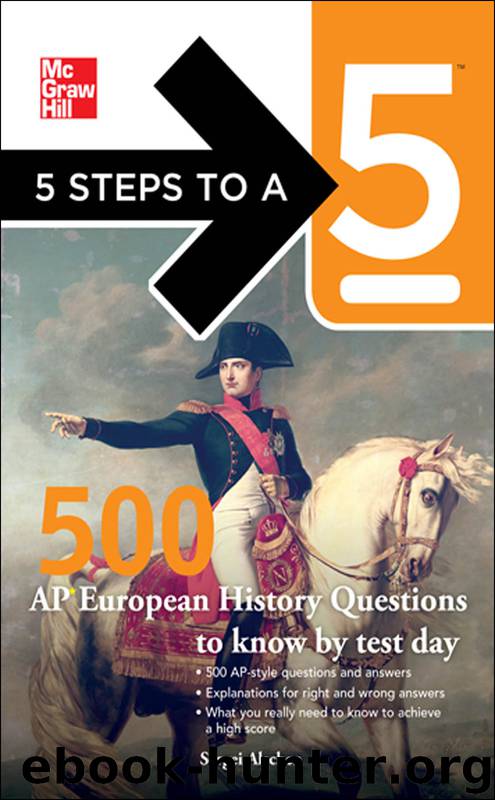500 AP European History Questions to Know by Test Day by Sergei Alschen

Author:Sergei Alschen
Language: eng
Format: epub
Publisher: McGraw-Hill Education
Published: 2012-04-20T04:00:00+00:00
Chapter 5: The Scientific Revolution During the 17th Century
113. (D) This theory is named after the ancient Greek astronomer Ptolemy (90–168). It is also known as the geocentric model of the universe. Options A and B are incorrect because Socrates and Plato were philosophers. Option C is incorrect because Diocletian was a Roman Emperor. Option E is incorrect because Hippocrates studied medicine, and the Hippocratic Oath is taken by health care professionals pledging to work ethically.
114. (B) Copernicus revealed his heliocentric model of the universe where the earth, and not the sun, was at the center of the universe, in his book, On the Revolutions of the Celestial Spheres, published in 1543. Options A and D are incorrect because Isaac Newton was responsible for both the theory of gravity and the development of calculus. Option C is incorrect because penicillin was discovered at the end of the 19th century and first used for medicinal purposes in the middle of the 20th century. Option E is incorrect because the periodic table of elements was developed by Russian scientist Dmitry Mendeleyev.
115. (C) In 1609, Galileo improved on earlier existing telescopes and was able to witness the changing positions of Jupiter’s moons. Option A is incorrect. Although his understanding of mathematics was advanced, it wasn’t a determining factor in confirming Copernicus’s theory. Option B is incorrect because Copernicus’s theory had nothing to do with the human anatomy. Option D is incorrect. Galileo claimed that the heliocentric theory didn’t contradict biblical writings on the world and the earth, but he also didn’t use those writings to confirm Copernicus’s theory. Option E is incorrect because alchemy and astronomy are completely separate fields of study.
116. (B) The discoveries made by Copernicus, Brahe, Kepler, and Galileo advanced human understanding of the universe and directly challenged the established scientific orthodoxy of the Catholic Church. The trial of Galileo in 1633 by the Roman Inquisition best exemplifies the threat the Catholic Church felt as a result of these advances. Option A can be viewed as correct but not in Europe. Catholic missionaries like Matteo Ricci brought news of many scientific advances by European scientists to China in the 17th century but not about the heliocentric theory, since the official church still rejected the theory. Option C is incorrect because there was little collaboration between the church and the “scientific community” at that time. Option D is incorrect because this has never happened. Option E is incorrect because the Protestant Reformation was triggered by what was viewed as corruption in the church (sale of indulgences) by Martin Luther.
117. (E) Anton Lavoisier, known as the “father of modern chemistry,” developed his theories in the 18th century. Medical advances included van Leeuwenhoek’s observation of bacteria and microorganisms with a microscope and William Harvey’s explanation of the circulatory system. Copernicus’s heliocentric theory of the universe was a major advance in astronomy, while in physics, Isaac Newton discovered the laws of gravitational motion.
118. (D) Aristocratic men with an interest in science received subsidies from the English government to pursue their scientific interests.
Download
This site does not store any files on its server. We only index and link to content provided by other sites. Please contact the content providers to delete copyright contents if any and email us, we'll remove relevant links or contents immediately.
Cracking the GRE Premium Edition with 6 Practice Tests, 2015 (Graduate School Test Preparation) by Princeton Review(3612)
ACT Math For Dummies by Zegarelli Mark(3573)
5 Steps to a 5 AP U.S. History, 2010-2011 Edition (5 Steps to a 5 on the Advanced Placement Examinations Series) by Armstrong Stephen(3410)
What It Really Takes to Get Into Ivy League and Other Highly Selective Colleges by Hughes Chuck(3233)
McGraw-Hill's SAT 2014 Edition (Mcgraw Hill's Sat) by Black Christopher & Anestis Mark(3148)
Kick Ass in College: Highest Rated "How to Study in College" Book | 77 Ninja Study Skills Tips and Career Strategies | Motivational for College Students: A Guerrilla Guide to College Success by Fox Gunnar(2728)
Graduate Admissions Essays, Fourth Edition: Write Your Way into the Graduate School of Your Choice (Graduate Admissions Essays: Write Your Way Into the) by Asher Donald(2486)
Get into Any College by Tanabe Gen Tanabe Kelly(2390)
500 Must-Know AP Microeconomics/Macroeconomics Questions(2248)
Easy Algebra Step-by-Step by Sandra Luna McCune(2137)
The Official Guide to the TOEFL Test by ETS(1922)
Open the Gates to the Ivy League: A Plan B for Getting into the Top Colleges by C. W. Henderson(1569)
Cracking the Sat French Subject Test, 2013-2014 Edition by The Princeton Review(1528)
Cracking the SAT Literature Subject Test, 2013-2014 Edition (College Test Preparation) by Princeton Review(1470)
Law School Essays that Made a Difference by Princeton Review(1469)
Barron's AP Calculus by David Bock(1455)
Cracking the AP Physics C Exam, 2018 Edition by Princeton Review(1410)
Barron's SAT Math Workbook by Lawrence S. Leff(1383)
ASVAB AFQT For Dummies by Rod Powers(1327)
